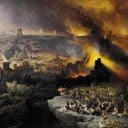Now that we have finished looking at the issues surrounding the Battle of Armageddon we will now take a look at battle found in Ezekiel 38 and 29 and how it related to the Gog and Magog invasion found in Revelation 20.
Rev 20:7 And when the thousand years are ended, Satan will be released from his prison 8and will come out to deceive the nations that are at the four corners of the earth, Gog and Magog, to gather them for battle;
First let us consider the different options for the battle described in Ezekiel 38 and 39. When should we find fulfillment of this battle? Is this a picture of a yet future confrontation? Is there something to be found in the ancient past that may supply an answer to this mystery? Below are the different options that have been promoted.
FUTURIST VIEW
The majority view - at least in modern American evangelicalism - is that this event takes place in our near future if it is related to the Battle of Armageddon in Revelation 16 or at the end of the Millennium. This view is held by many different eschatological and Millennial positions, though the placing of the battle in relation to the Battle of Armageddon would be most closely associated with Dispensationalism.
Difficulties with this view have been addressed previously and deal with the antiquity of the nations and weaponry of the battle as described. This is even more so troubling as the view is most often promoted by those who demand a “wooden literal” interpretation of the Scriptures.
SYMBOLIC VIEW
This view argues that the text is purely symbolic and involves symbolic imagery relating to God’s providential care of His people. This picture shows a God that rescues and provides for His people no matter the odds and no matter the enemy.
This view cannot adequately deal with the specifics of the passage and lacks any true prophetic pronouncement or potential fulfillment.
MACABBEAN REVOLT
Many have argued this event was fulfilled during the time of the Macabbean Revolt. This view argues that the enemy in question is Antiochus Epiphanies which would fit the Persian expectation and the worldwide expanse of the Persian empire at that time.
The problems with this view include that this a battle of attack against Israel that appears to be fought off during the attack while the Macabbean revolt is one that threw off an occupying force after several years. The picture shown in Ezekiel is one that has more to do with a victory against a coming army or foe.
ESTHER VIEW
In this view it is argued that the fulfillment is found during the time of Esther and involves the Israelite victory over Haman’s “schemes” and complete victory of the outmatched Israel forces. A soon to be released book by Gary DeMar, Why the End of the World is Not in Your Future, addresses this point in great detail and I would recommend it to those who are interested in this view and a more detailed approach to dealing with Ezekiel 38 and 39. I will post a link below to the book. The basic points are as follows.
- Israel’s great and most evil antagonist in the Bible was Haman. DeMar compares his work with that of Hitler
- A Hebrew manuscript identifies Haman as a “Gogite”
- We learn that in both cases the enemy of Israel would come up against unwalled towns and cities (Est 9:9 and Eze 38:11). This could only take place during the initial return to Jerusalem when the Temple was built but the walls had not been. Today’s Israel has miles and miles of fortified walls.
- Ezra and Nehemiah both mention the large amounts of silver and gold that the Jews brought back from exile. These are the same items we are told the approaching armies were attacking to plunder.
- The battle with Haman’s armies takes place after Israel is returned to the land - during Darius’ reign
- Esther and Ezekiel’s enemies from the north both contain Persia and Ethiopia
- In fact both passages state that the Jews were attacked by all of Persia’s provinces
- In a very short battle the Israelites destroy Haman’s army killing nearly 100,000 despite being greatly out-manned
For a more detailed account of this position see…
http://www.americanvision.com/endoftheworldisnotinyourfuture.aspx
If the latter arguments are correct that one must understand the reference to Gog and Magog in Revelation metaphorically. The events that surround the releasing of Satan at the end of the Millennium will be similar to the kind of attempted oppression and persecution found in Ezekiel 38 and 39 and the possible parallels to Esther. Further discussion on the options for interpretation will take lace when we walk through the main themes of revelation in future posts.
This, like many other events that have been relocated to our future, best fits an ancient fulfillment. This is an admittedly difficult portions of Scripture but the fact remains that one should look to the past before demanding that a articular event must somehow fit into our future.
Next we will begin a discussion of the Book of revelation. This will not be a Commentary on Revelation, but rather an overview of theme and hermeneutical options. I will also be listing several resources for further study as well.





No comments:
Post a Comment